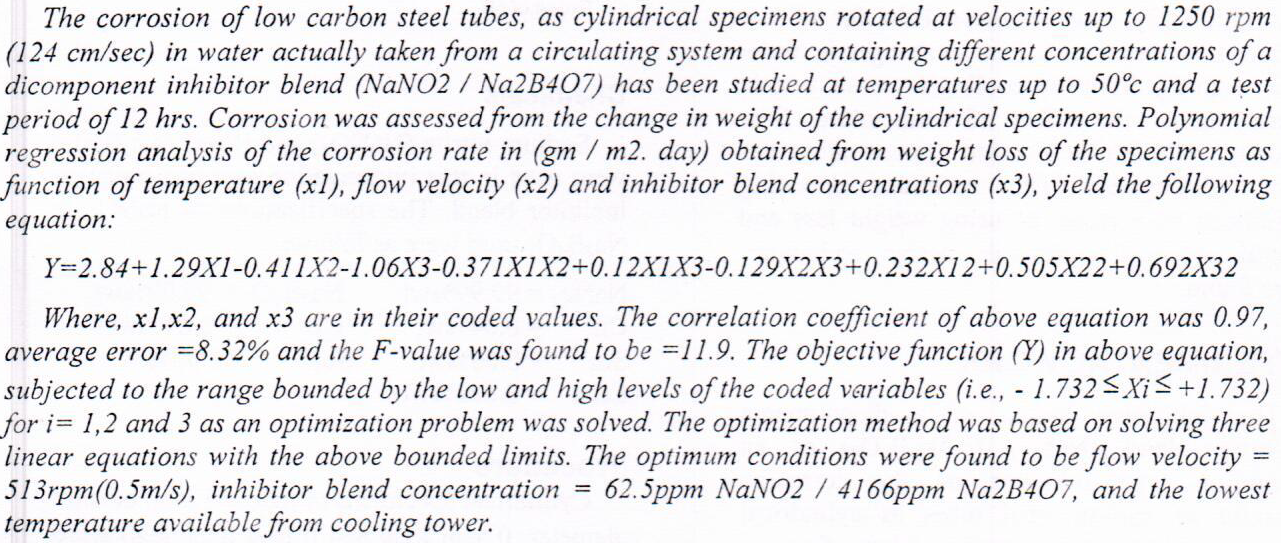
The work demonstrates the effect of cold atmospheric plasma (CAP) on adult female rats suffering from osteoporosis, the used plasma was generated by a floating electrode-dielectric barrier discharge system with an electrode diameter of 3 cm. The output power was from (12-20) watts. The effect of non-thermal plasma was observed on rats with various exposure times of 20, 30, and 40 sec. It was noted that the blood calcium percentage of animals exposed to cold plasma increased, as well as an increase in the level of vitamin D3 at the same time, it is noted that there is no effect on parathyroid hormone level. For the thyroid gland, it is noticed an increase in the level of T3, and T4 hormones in the blood during the period of induction for
... Show More (1)
(1)
 (39)
(39)
 (31)
(31)
In this research, the water quality of the potable water network in
Al-Shuala Baghdad city were evaluated and compare them with the
Iraqi standards (IQS) for drinking water and World Health
Organization standards (WHO), then water quality index (WQI) were
calculator: pH, heavy metals (lead, cadmium and iron), chlorides,
total hardness, turbidity, dissolved oxygen, total dissolved solid and
electrical conductivity. Water samples are collected weekly during
the period from February 2015 to April 2015 from ten sites. Results
show that the chlorides, total dissolved solid and electrical
conductivity less than acceptable limit of standards, but total
hardness and heavy metals in some samples higher than acceptabl
 (1)
(1)
The erythrocyte aggregation is an important physiological phenomenon in the circulation of blood. It is a basic characteristic of normal blood that plays a major role in the cardiovascular system, especially in the microcirculation. This study explained the kinetics of single cells rouleaux formation one- dimensional aggregate and three- dimensional aggregate, during simultaneous, and the effect of hematocrit on the process of aggregation and sedimentation. The present study was done on forty one healthy subjects. Laser light is passed through a well mixed sample of blood and the forward scattered light intensities recorded continuously. The samples were prepared with different hematocrit, (10%, 15%, 20%, and 25%). Increasing
... Show MoreAbstract:
The researcher shed light on a diet in Iraq before 2003 became in this period. And how the ration card has a variety of vocabulary and cover the need of the population of commodities and have a key role in saving Iraq from a real crisis in the period of economic siege, especially in light of the State's direction to support the agricultural sector, which in that period able to fill half of the market needs of food the basic. As well as providing strategic storage at the Ministry of Commerce enough for six months But after the events of 2003 and the crises that hit the country and the unstable security situation began to rise voices calling for reform of the ration card system as a system that is a burden on the
... Show MoreAbstract
The objective of this research is to identify the analysis of the ethics of the administration in the development of the social responsibility of one government organizations, and to achieve the objectives of the research was the use of a questionnaire developed for the purpose of data collection and distribution to the research sample, was chosen as a total sample population (50) individuals were relying on statistical package to do a statistical analysis for this research, user, ANSI (SPSS) simple regression analysis, standard deviation, Pearson correlation coefficient.
Research findings show the role of social responsibility in achieving the university's strategy,
... Show MoreThe research aims to know the impact of workers values on their performance which is reflected on increasing productivity and improving its quality as well as the organization's progress and success. Application of this research took place in the General Company Of Electrical Industries; it contained four main pillars; the first involved research methodology، regarding the problem، importance، aim، basic theory، and method of data collection، the second is dedicated to the theoretical framework related to the research basic variables (values and workgroups) the third is assigned to analyze the actual data by using number of statistical methods، such as mathematical medium and standard deviation and also spearman rank
... Show MoreIn this study, the effects of different loading doses of cerium in the prepared NaY zeolite from Iraqi kaolin were investigated. Al-Duara refinery atmospheric residue fluid catalytic cracking was selected as palpation reaction for testing the catalytic activity of cerium loading NaY zeolite. The insertion of cerium in NaY zeolites has been synthesized by simple ion exchange methods. Three samples of modified zeolite Y have been obtained by replacing the sodium ions in the original sample with cerium and the weight percent added are 0.35, 0.64, and 1.06 respectively. The effects of cerium loading to zeolite Y in different weight percent on the cracking catalysts were studied by employing a laboratory fluidized
... Show MoreThis research deals with the effects of welding variables using MIG/MAG spot by using Argon (Ar) gas and CO2 to show their effect on the mechanical characteristics and microstructure of low alloy steel type DIN15Mo3 and determine the optimum condition for the process of welding ; current & time. The results show the possibility of using CO2 and also Ar in low alloy steel welding with a little decrease in the shear force of not more than 13% for 4mm thickness and time 2sec. The shear force increased when using Ar instead of CO2 to be , The shear force reach 36KN when using Ar at 2mm thickness time of 8 sec and current of 220 Amp. , when used CO2 instead of Ar d
... Show More (6)
(6)
 (6)
(6)
